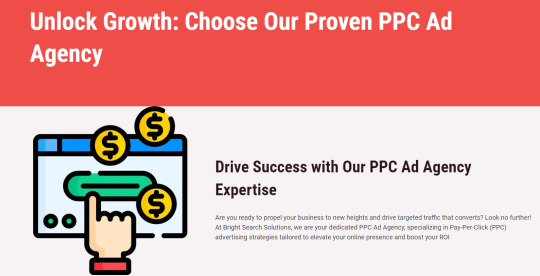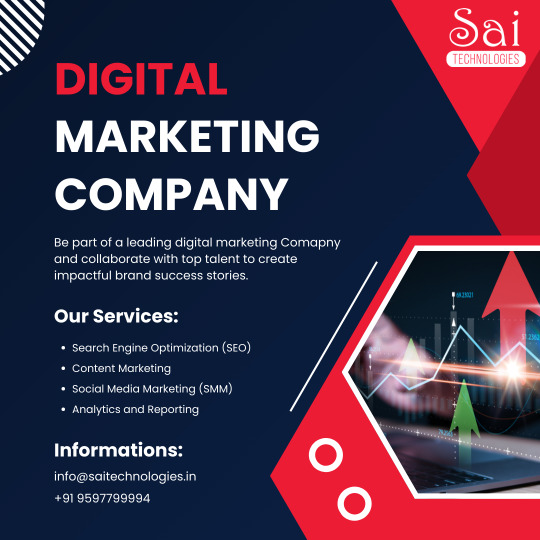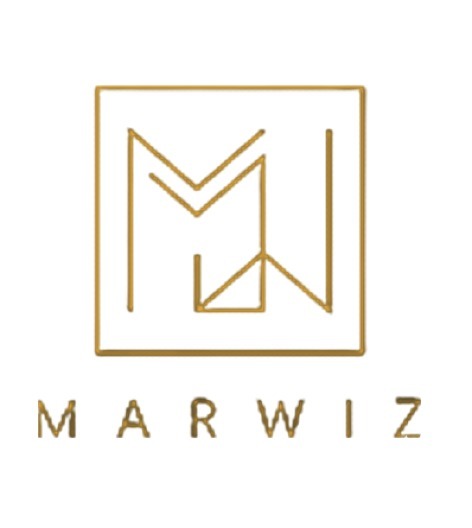#Ad Performance Analytics
Explore tagged Tumblr posts
Text

Unlock Growth: Choose Our Proven PPC Ad Agency
#PPC Advertising Services#Google Ads Specialists#Geo-Targeted PPC#PPC Consultancy#Social Media PPC#Ad Performance Analytics
0 notes
Text

In the digital transformation, where consumers are constantly connected and businesses compete for visibility online, digital marketing has become a cornerstone of success. From startups to global enterprises, companies are investing in digital strategies that not only expand their reach but also build strong, lasting relationships with their audiences.
#digital marketing#online marketing#SEO services#social media marketing#content marketing#email marketing#PPC advertising#search engine optimization#digital advertising#internet marketing#marketing automation#local SEO#influencer marketing#Google Ads#Facebook Ads#performance marketing#digital branding#website traffic growth#lead generation#marketing analytics
0 notes
Text

#digital marketing#best digital marketing company#emailmarketing#google ads#market research#search engine optimization#online marketing#seo services#digital marketing agency#digital marketing services#pay per click#social media marketing#social media agency#social media management#contentmarketing#market trends#analytics#ppc services#ppcadvertising#performance marketing
0 notes
Text
The 8 Most Important PPC KPIs You Should Track for Business
Discover the most crucial PPC KPIs for driving sustainable business growth. Learn why profit, incrementality, and LTV are the game-changers in modern PPC campaigns. The 8 Most Important PPC KPIs You Should Be Tracking If you’re still measuring your PPC success based on click-through rate (CTR) and impressions alone, you’re about to be left behind. The role of paid media has evolved. It’s not…
#contribution to pipeline#conversion rate in PPC#customer lifetime value#digital marketing KPIs#Google Ads metrics#incremental acquisition#lead quality in PPC#marketing campaign success#paid media optimization#PPC analytics#PPC KPIs#PPC performance metrics#PPC strategy#profit tracking in PPC#ROAS#time to conversion
0 notes
Text
AI-Driven Marketing: Set It & Forget It
AI-Driven Marketing Set It & Forget It 💡 Ever wish you could run Facebook & Google ads without hiring an expert? AI-powered ad management can optimize your budget and scale results! Marketing Without the Overwhelm: Is It Possible? Running ads sounds easy, until you actually start. One minute, you’re setting up a simple Facebook ad, and the next, you’re buried in audience targeting, budget…
#AI ad budget management#AI ad optimization#AI ad personalization#AI ad scaling#AI advertising tools#AI campaign automation#AI chatbot marketing#AI customer acquisition#AI email marketing optimization#AI for conversion optimization#AI for digital advertising#AI for Google Ads#AI for lead generation#AI for PPC advertising#AI for ROI maximization#AI for sales funnel automation#AI for small business marketing#AI in B2B marketing#AI in eCommerce marketing#AI in influencer marketing#AI in performance marketing#AI in social media marketing#AI marketing analytics#AI marketing automation#AI marketing intelligence#AI marketing strategy#AI marketing tools for entrepreneurs#AI marketing workflow automation#AI predictive analytics#AI social media ads
1 note
·
View note
Text
Understanding Meta Ads Metrics: What Small Businesses Need to Track
Maximise your Meta Ads performance by tracking key metrics like CTR, CPC, ROAS, and conversion rates. Learn how small businesses can optimise PPC campaigns for higher ROI and sustainable growth. Get expert insights to refine targeting, bidding, and ad creatives. Contact Koobr today for cost-effective Meta Ads strategies.
#PPC advertising UK#small business PPC tips#Facebook Ads tracking#conversion rate tracking#cost per acquisition PPC#Meta Ads analytics#ad frequency management#digital ad performance#paid social media strategy#Koobr
0 notes
Text
Streamlining Ad Displays with Data-Driven Insights
Streamline ad displays, gain actionable insights, and optimize campaigns with Marwiz Tech. Discover services like market research, media planning, and performance analytics.

#Virtual ad management#advertising solutions#ad display optimization#data-driven insights#market research services#media planning#performance analytics
0 notes
Text
#Social Media Advertising#Targeted Advertising#Customer Engagement#Real-Time Feedback#Analytics in Marketing#Brand Awareness#Cost-Effective Marketing#Ad Performance Optimization#Sales Growth through Advertising#Digital Marketing ROI
0 notes
Text
Facebook Ads Metrics Explained: What to Track and Why

1. Click-Through Rate (CTR)
CTR is one of the most crucial metrics in assessing the relevance and engagement level of your Facebook Ads. It is calculated as the percentage of users who clicked on your ad after seeing it. A high CTR indicates that your ad resonates with your target audience.
Why Track CTR?
Determines the effectiveness of your ad creative and messaging.
Helps in identifying underperforming ads that require optimization.
Influences your ad’s Quality Score, ultimately impacting CPM (Cost Per Mille) and ad placement.
How to Optimize CTR:
Use compelling visuals and clear calls-to-action.
Test different ad formats and copy variations.
2. Cost Per Mille (CPM)
CPM refers to the cost you pay for every 1,000 impressions of your ad. It is a critical metric for understanding the cost efficiency of your campaign.
Why Track CPM?
Provides insights into how competitive your target audience is.
Helps in budgeting for broader reach campaigns.
How to Optimize CPM:
Narrow your audience targeting to reduce competition.
Improve ad relevance by focusing on audience-specific content.
3. Return on Ad Spend (ROAS)
ROAS measures the revenue generated for every dollar spent on Facebook Ads. It is a direct indicator of your campaign’s profitability.
Why Track ROAS?
Helps evaluate the financial performance of your ad campaigns.
Identifies which ads, audiences, or products drive the most revenue.
How to Track ROAS Effectively:
Use Facebook’s conversion tracking tools.
Integrate Facebook Pixel to monitor website activities and sales.
4. Engagement Metrics
Engagement metrics include likes, shares, comments, and reactions. While these may not directly contribute to sales, they are essential for building brand awareness and trust.
Why Track Engagement Metrics?
Indicates the emotional and social impact of your ads.
Helps gauge audience interest in your brand.
How to Boost Engagement:
Post engaging and interactive content.
Use videos or carousel ads to capture more attention.
5. Conversion Rate
Conversion rate is the percentage of users who complete a desired action, such as making a purchase, signing up for a newsletter, or filling out a form.
Why Track Conversion Rate?
Measures how well your ads are driving actions aligned with your campaign objectives.
Indicates the effectiveness of your landing pages and sales funnel.
How to Improve Conversion Rate:
Ensure your landing pages are optimized for speed and relevance.
Use retargeting to re-engage users who didn’t convert initially.
6. Frequency
Frequency refers to the average number of times a single user sees your ad. While repeated exposure can increase brand recall, excessive frequency can lead to ad fatigue.
Why Track Frequency?
Helps maintain a balance between visibility and annoyance.
Affects the overall performance and ROI of your campaign.
How to Manage Frequency:
Cap the frequency in your campaign settings.
Regularly refresh your ad creatives.
7. Ad Placement Metrics
Facebook offers multiple ad placements, including the news feed, stories, and audience network. Each placement has its performance metrics.
Why Track Placement Metrics?
Identifies the best-performing placements for your ads.
Allows budget allocation to the most effective channels.
How to Optimize Placements:
Use automatic placements for better algorithm optimization.
Analyze placement-specific performance data.
8. Bounce Rate
Bounce rate measures the percentage of users who clicked on your ad but left your website without taking any action.
Why Track Bounce Rate?
Indicates the relevance of your landing page.
Helps identify issues with user experience.
How to Reduce Bounce Rate:
Ensure landing pages align with ad content.
Simplify navigation and reduce page load times.
Why Facebook Ads Analytics Matter
Understanding and analyzing Facebook Ads Performance Metrics is critical for achieving your advertising goals. Metrics like CTR, CPM, and ROAS provide actionable insights into how your campaigns are performing, enabling you to make data-driven decisions.
As a trusted PPC Marketing Agency in Pune, we specialize in CTR and CPM Optimization and helping businesses Track ROAS Effectively. By focusing on these metrics, you can measure success, refine strategies, and maximize your ROI.
#PPC Marketing Agency in Pune#Facebook Ads Performance Metrics#CTR and CPM Optimization#Track ROAS Effectively#Measure Facebook Ad Success#Facebook Ads Analytics Guide
0 notes
Text
How Does Tracking Work on Google Ads?

In today's digital marketing landscape, understanding how your advertising campaigns perform is crucial for optimizing efforts and maximizing return on investment (ROI). Google Ads offers robust tracking tools that enable marketers to measure success accurately and make informed decisions. In this blog, we'll explore how tracking works in Google Ads, its key components, best practices, and tips for effective utilization.
1. Understanding Google Ads Tracking
Google Ads tracking is the process of collecting and analyzing data related to ad performance, user interactions, and conversion metrics. With this information, advertisers can refine their strategies, enhance audience targeting, and improve campaign effectiveness.
2. Key Components of Google Ads Tracking
a. Conversion Tracking
Conversion tracking is a fundamental aspect of Google Ads. It allows advertisers to measure specific actions users take after interacting with their ads, such as:
Purchases: Understanding sales generated through ads.
Sign-Ups: Tracking newsletter subscriptions or account creations.
Form Submissions: Monitoring contact form completions.
Fact: According to Google, advertisers using conversion tracking see an average increase of 20% in conversions.
How to Set Up:
Go to "Tools and Settings" in your Google Ads account.
Select "Conversions" and create a new conversion action.
Implement the conversion tracking tag (pixel) on your website.
b. Google Analytics Integration
Integrating Google Analytics with Google Ads provides deeper insights into user behavior. By linking these platforms, you can:
Analyze metrics like bounce rate, session duration, and page views.
Gain insights into audience demographics and interests.
Track user pathways from ad click to final conversion.
Tip: Make sure to set up goals in Google Analytics that align with your conversion actions in Google Ads for comprehensive tracking.
c. Tracking URL Parameters
URL parameters allow advertisers to track the performance of specific campaigns, ad groups, or keywords. By appending tracking parameters to your destination URLs, you can gather detailed information about how users arrived at your site.
Common Parameters:
utm_source: Identifies the source of traffic (e.g., Google, Facebook).
utm_medium: Indicates the medium used (e.g., CPC, email).
utm_campaign: Defines the campaign name for tracking.
Trick: Use Google’s Campaign URL Builder to easily create tagged URLs.
3. Advanced Tracking Features
a. Remarketing Lists for Search Ads (RLSA)
RLSA allows you to tailor your search ads for users who have previously visited your website. By tracking user behavior, you can create specific audience segments and adjust your bidding and messaging accordingly.
Fact: Businesses using RLSA see an average conversion rate increase of 50%.
b. Enhanced Ecommerce Tracking
For e-commerce websites, Enhanced Ecommerce tracking provides in-depth insights into the shopping behavior of users. It tracks product impressions, clicks, add-to-cart actions, and more.
Tip: Implement Enhanced Ecommerce tracking to analyze user behavior at each stage of the buying process.
4. Analyzing and Interpreting Data
Once your tracking is set up, analyzing the data is crucial for understanding campaign performance. Focus on key metrics:
Click-Through Rate (CTR): Measures how often people click your ad after seeing it. A higher CTR indicates effective ad copy and targeting.Tip: Test different ad copy and visuals to find what resonates with your audience.
Cost per Acquisition (CPA): Calculates how much you spend to acquire a customer. Aim to lower your CPA while maintaining conversion rates.
Conversion Rate: The percentage of users who complete a desired action after clicking your ad. A higher conversion rate suggests effective targeting and ad relevance.
Return on Ad Spend (ROAS): Measures the revenue generated for every dollar spent on ads. A higher ROAS indicates a successful campaign.
Fact: Advertisers should aim for a ROAS of at least 400% (or a 4:1 ratio) to ensure profitability.
5. The Importance of Google Ads Tracking
Effective tracking in Google Ads is essential for several reasons:
Informed Decision-Making: Understanding which ads and keywords perform best allows for better budget allocation.
Optimization Opportunities: Tracking helps identify underperforming ads, keywords, or targeting options, enabling marketers to refine their strategies.
ROI Measurement: Knowing the ROI of your campaigns helps justify your advertising spend and demonstrates the value of your marketing efforts.
6. Best Practices for Google Ads Tracking
Regularly Review Your Data: Set a schedule to review performance data and adjust your campaigns accordingly.
A/B Testing: Continuously test different ad elements (headlines, descriptions, images) to identify the most effective combinations.
Use Automated Rules: Google Ads allows you to set automated rules for adjusting bids, pausing ads, or changing budgets based on performance metrics.
Keep Your Tags Organized: Use descriptive names for conversion actions and tracking parameters to maintain clarity as your campaigns grow.
Conclusion
Google Ads tracking is a vital component of successful digital marketing. By implementing conversion tracking, integrating Google Analytics, and utilizing advanced tracking features, marketers can gain valuable insights into their campaigns' performance. This data-driven approach enables informed decision-making, optimization, and ultimately, better ROI. To implement effective SEO strategies for long-term growth, visit GoToGroww.com and connect with me to explore how we can elevate your business.
#Google Ads#Digital Marketing#Conversion Tracking#Online Advertising#PPC Management#Google Analytics#Marketing Strategy#Ad Performance#SEO and SEM#E-commerce Tracking#Digital Advertising Tips
0 notes
Text

Maximize ROI with Expert Paid Ad Services
Boost your ROI with Go To Groww premium Paid Ad services. Our expertise includes ad creation, A/B testing, performance analytics, and remarketing. We ensure effective campaign management and budget optimization for impactful results across digital platforms.
0 notes
Text
Unlock Growth: Choose Our Proven PPC Ad Agency
Are you ready to propel your business to new heights and drive targeted traffic that converts? Look no further! At Bright Search Solutions, we are your dedicated PPC Ad Agency, specializing in Pay-Per-Click (PPC) advertising strategies tailored to elevate your online presence and boost your ROI
#PPC Advertising Services#Google Ads Specialists#Geo-Targeted PPC#PPC Consultancy#Social Media PPC#Ad Performance Analytics
0 notes
Video
tumblr
How to measure TikTok ad success? How do you measure TikTok ad success? Are you struggling to understand if your TikTok ads are working? In this video, I’ll guide you through the key metrics that matter. You’ll learn how to track performance using views, engagement rates, and conversions. Understanding these metrics can help you make informed decisions. By watching, you’ll gain insights into what works and what doesn’t. This knowledge will help you refine your strategy for better results. I’ll also share tips on how to analyze your data effectively. This way, you can adapt your ads to meet your audience’s needs. Whether you’re a beginner or have some experience, this video is for you. Join me as we break down the steps to evaluate your TikTok advertising efforts. You’ll walk away with practical tools to assess your campaigns and improve your outcomes. Don’t miss out on this chance to enhance your TikTok marketing skills! #TikTokMarketing #AdMetrics #SocialMediaSuccess #MarketingTips #TikTokAds #shorts #SubhamDas Full Video:- https://youtu.be/EtEWFmpY_Hw
#subham das#TikTok ad success#measuring TikTok ads#TikTok advertising metrics#social media marketing#TikTok engagement#ad performance#marketing strategy#TikTok analytics#ad conversions#SubhamDas
0 notes
Text

#digital marketing services#web development#web design#digital marketing#best digital marketing company#digital marketing agency#online marketing#seo services#google ads#search engine optimization#emailmarketing#social media marketing#social media posts#social media agency#social media#social marketing#social media management#ppc services#ppcadvertising#marketing agency#marketing strategy#marketingdigital#market research#marketing#analytics#performance marketing#performance analysis
1 note
·
View note
Text
Navigating the Performance Max Maze:A Marketer’s Candid Journey
Hey there, fellow digital marketing warriors! Today, I’m going to spill the beans on my six-month adventure with Google’s Performance Max campaigns. Buckle up, because it’s been quite a ride!

1. My First Encounter with Performance Max
I still remember the day Google announced Performance Max. My first thought?
“Great, another AI thing to learn.” But as I dug deeper, I felt a mix of excitement and anxiety. The promise of AI-driven, cross-channel campaigns sounded amazing, but could I trust an algorithm with my precious ad budget?
2. The Honeymoon Phase: Early Wins
Like any new relationship, Performance Max and I started off strong. Within the first month, I was seeing some impressive results:
My ads were showing up in places I’d never considered before
Conversion rates were climbing
I was spending less time on manual optimizations
I felt like a digital marketing genius. “This is it,” I thought, “The future of advertising!”
3. Reality Check: Challenges and Setbacks
But then, reality hit. And it hit hard.
Remember that saying about things that seem too good to be true? Yeah, that.
The lack of granular control started to bug me. I couldn’t tweak individual placements or bids like I used to. And don’t get me started on the day my conversion tracking went haywire, and Performance Max decided to go on a spending spree. Let’s just say I didn’t sleep much that week.
4. Lessons Learned and Strategies Developed
After a few months of trial and error (emphasis on the error), I started to get the hang of things. Here are some key lessons I learned:
Patience is crucial. The AI needs time to learn and optimize.
Quality input = quality output. The better your assets and goals, the better your results.
Keep a hawk’s eye on performance, especially in the beginning.
Don’t be afraid to experiment with different asset combinations.
5. Where I Stand Now: The Verdict
Six months in, where do I stand with Performance Max?
I’d say we’re in a “it’s complicated” relationship status. On one hand, it’s opened up new opportunities and saved me time. On the other, it’s been a challenging learning curve with some heart-stopping moments.
Would I recommend it?
Yes, but with a caveat: Be prepared to learn, adapt, and sometimes grit your teeth.
6. FAQ
Q: Is Performance Max suitable for small businesses?
A: It can be, but start with a small budget and closely monitor performance.
Q: How long does it take to see results?
A: In my experience, it took about 2-3 weeks to start seeing meaningful data.
Q: Can I still use my existing campaigns alongside Performance Max?
A: Absolutely! In fact, I recommend a hybrid approach, especially when starting out.
Q: What’s the biggest advantage of Performance Max?
A: For me, it’s the time saved on manual optimizations and the expanded reach across channels.
Q: What’s the biggest challenge?
A: The loss of granular control can be frustrating, especially for seasoned PPC managers.
7. Conclusion
Performance Max isn’t perfect, but it’s a powerful tool when used correctly. It’s pushed me out of my comfort zone and made me rethink some of my long-held PPC strategies. As with any new technology, the key is to approach it with an open mind, a willingness to learn, and a healthy dose of caution.
Remember, your mileage may vary. What worked (or didn’t work) for me might be different for you. The most important thing is to stay curious, keep learning, and don’t be afraid to share your experiences with fellow marketers. After all, we’re all in this wild, AI-driven ride together!
So, what’s your take on Performance Max?
Have you tried it yet?
I’d love to hear about your experiences in the comments below. Let’s keep this conversation going!,
#seo services#branding#social media metrics#marketing metrics#facebook ads#google ads#google analytics#facebook advertising#social media#performance
1 note
·
View note
Text
Use Facebook Analytics to Grow your Business | Kartapult
Facebook analytics is used to track the brand's performance. Data provides insights on audience details, page performance and content effectivenes.
#kartapult#automation tool#marketing automation#performance marketing tool#Facebook ads#e-commerce ads#facebook analytics
0 notes